12.5 Analyzing Public Art: Descriptive Summary and Rhetorical Analysis
At LCCC, outside of Stocker Arts Center, where the English department is housed, is a sculptured titled The Gift. Made in 1999 by Cleveland artist Dale Slavin, the work was commissioned by the LCCC Foundation as a piece of public art to encourage LCCC students to reach for your dreams.
The Gift is unique in that it combines both visual aesthetics and the written word to deliver its message. Etched into the sculpture are four significant quotations. This combination of discourses means that The Gift lends itself readily to both visual and rhetorical analysis—similar to the examples that you studied in the Advertising section above.
If you are on campus for classes or a Writing Center appointment, or if you live nearby, you can stop outside of the Stocker Arts Center and spend some time looking at The Gift. If not, several images are provided for you below.
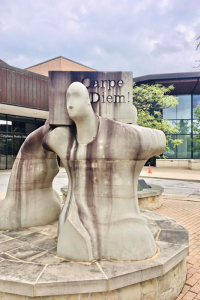
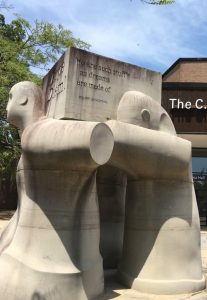
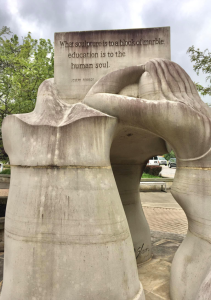
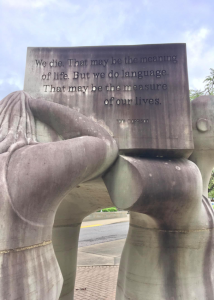
Descriptive Summary of The Gift
To write a descriptive summary of The Gift, begin by studying it closely and use your observations to complete the following.
Step 1. Describe the sculpture, giving your best approximations where necessary:
- Title
- Artist
- Location/Site/Context
- Other people involved
- Materials
- Size
- Components
Step 2. Describe the components of the sculpture: Three Figures/Statues
Step 3. Describe the components of the sculpture: Etched Quotes
Step 4. How do the sculpted figures and the quotes make you feel? What is your response to the message(s)? Which of the four quotations resonates with you the most, and why?
Step 5. If you had to summarize the overall argument or story of sculpture, what would you say? How do the sculpted figures of the people relate to the words carved above them?
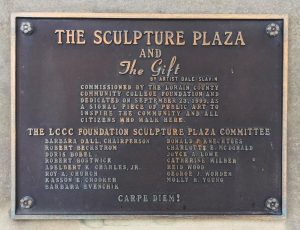
Rhetorical Analysis of The Gift
After you have completed the Descriptive Summary, try your hand at a Rhetorical Analysis of The Gift, answering the following questions:
- Looking at the placard near The Gift, who commissioned the sculpture? What was the motivation for creating the sculpture? What perceived need or larger situation is the sculpture responding to? What is the context and setting for The Gift? What is the significance of the title?
- Shakespeare’s line spoken by Prospero in The Tempest is “We are such stuff as dreams are made on.” What is the message underlying The Gift when the line has been adapted to “We are such stuff as dreams are made of”?
- Who is “we”? Who is the audience? What is the context and setting?
- Considering that you are a part of the intended audience for The Gift, how do the sculpted figures and the quotes make you feel? What is your response to the message(s)?
- Looking at The Gift, where do you see examples of ethos? logos? pathos?
- In addition to the Shakespeare, the sculpture quotes Toni Morrison. Why are Morrison and her statement especially relevant to Lorain County?
- The phrase “carpe diem!” heads the statue, and it is repeated on the placard. What does this phrase mean, and why repeat it? Why not translate it?
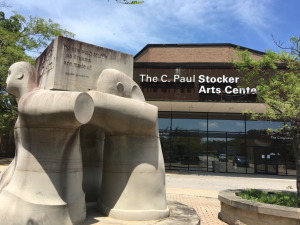
Adding Context to The Gift: Rhetorical Analysis
To expand your analysis of The Gift, you can learn more about the literary works and the authors behind some of the quotations on the sculpture.
The phrase “Carpe diem!” appears twice in relationship to The Gift. This phrase, meaning “seize the day!” is associated with English poets writing in the middle of the seventeenth century. What is the relevance of using this phrase? What meaning does it take on given that the audience includes students and the setting is a college campus?
Another quotation on The Gift—“We die … but we do language”—comes from the 1993 Nobel Prize speech by Lorain’s own Toni Morrison.
Follow the link to listen to her full speech. Then write an analysis of Morrison’s speech. Here are some questions to consider:
- Nobel Prize speeches are given by some of the most heady, intellectual people in history. They are typically logic-driven by definition and, therefore, meant to appeal to logos. What was the context for Morrison’s Nobel acceptance speech, and who was the audience? Morrison’s speech is a bit different from the typical. How so? Summarize the premise of Morrison’s speech. What is the speech about? Where do you see her using pathos, ethos, and logos? Of the three rhetorical appeals, which would you say is the one she uses the most often?
- Applying the concept of ethos to an analysis of Toni Morrison herself, when you think of Morrison, what are 6-8 of the best-chosen adjectives (or nouns) that come to mind to describe her? What would you say about Toni Morrison’s own ethos—her overall reputation? Why it is so significant that she is included as one of four quotes on the sculpture The Gift at LCCC? It may be helpful to remember that Morrison is the only woman, the only person of color, the only American, and the only contemporary author included in The Gift. All of the other quotations were written by 17th-century male British authors.
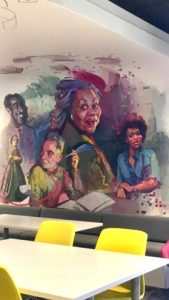
Toni Morrison takes pride of place in this mural of Ohio authors, commissioned as part of The Writing Center at Stocker Arts Center. Why is it fitting that Morrison figures so prominently in LCCC’s art?
Continue Reading: 12.6 Analyzing Film: Evaluation and Interpretation
